 Cars & Forecasting: Speed or Accuracy?
Cars & Forecasting: Speed or Accuracy?
Linkedin
April 17, 2021
During 2020 lockdown I discovered a specialist television channel called Motor Trend which presents lots of shows about people mucking about with vehicles.
I'm particularly fond of the ones about old vehicle restoration, usually against the clock, with tight budgets, in a limited space, with incompatible parts, inappropriate tools, unreasonable expectations and characters with well, character.
Can you see where I'm going with this yet?
See publication
Tags: Business Strategy, Predictive Analytics, Supply Chain
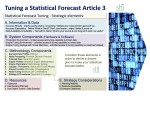 Tuning a Statistical Forecast Article 3: Strategic Elements.
Tuning a Statistical Forecast Article 3: Strategic Elements.
Linkedin
April 12, 2021
Do you have Statistical Forecast Creation Problems? This article presents more details about the key pillars of a statistical tuning program.
️ Data: (What) & Information (What is bad & What would be good).
Systems: Where do you do the tuning?
Methodology: The 9 steps of actually doing the tuning.
Resources: Who can do the tuning.
Strategy: What are your Business objectives?
If you need help defining or implementing a strategy - send me a DM and let's start a conversation.
See publication
Tags: Business Strategy, Predictive Analytics, Supply Chain
 Getting Value from the Supply Chain Sell-Through
Getting Value from the Supply Chain Sell-Through
LinkedIn
March 30, 2021
An article on Buy-In and Sell-Out.
The Demand Signal (What your Customer Buys) is the most important element for Demand Planning. The signal from your customer drives your forecast.
The most important signal for your Customers Demand Planning is the Demand Signal they get from their Customer and so on down the Supply Chain.
The further away from the end-Customer, the less easy it is to obtain and read that primary demand signal and generally, the further from the ultimate demand, the less significance is applied to it.
Getting closer to the demand signal is vitally important. How close are you?
See publication
Tags: Predictive Analytics, Retail, Supply Chain
 Buy-In and Sell-Out
Buy-In and Sell-Out
SHJ Consulting Ltd
March 29, 2021
Buy-In & Sell-Out are the terms used to describe the purchasing of product and the selling of product and are used most frequently in Retail Supply Chain settings to manage inventory and promotion activity.
In the Retail world of fast-moving goods Sell-Out is synonymous Point of Sale since the final (regular) end-Customer transaction is at the POS. The term can be used across other Industries although beyond Retail the more common terms that are similar to Buy-In are Sell-In, Inventory, Stock, Supply, Goods and to Sell-Out are Sales, Orders, Actuals.
The main distinction for Buy-In and Sell-Out however is that these transactions are often related to each other by price, promotion and time constraints. That is, the goods that are sold (Sell-Out) are from a specific batch of products that were bought (Buy-In).
See publication
Tags: Predictive Analytics, Retail, Supply Chain
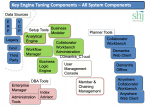 Oracle Demantra Statistical Engine Tuning Components
Oracle Demantra Statistical Engine Tuning Components
SHJ Consulting Ltd
March 29, 2021
Presenting some of the methods and components required to perform engine tuning
See publication
Tags: Analytics, Predictive Analytics, Supply Chain
 What is a Forecasting Strategy?
What is a Forecasting Strategy?
LinkedIn
March 27, 2021
What is a Forecasting Strategy? What does it do? How can it be defined? Does it work?
Demand Planning doesn't need to be a painful task to be completed with restricted data in the shortest possible time! A Forecasting Strategy can help you change mindset, process, systems and data and achieve forecasting nirvana!
Find out how this seemingly impossible dream can be yours to own. For free!
See publication
Tags: Business Strategy, Predictive Analytics, Supply Chain
 Tuning a Statistical Forecast Article 1: Resource Options
Tuning a Statistical Forecast Article 1: Resource Options
LinkedIn
March 24, 2021
Tuning a Statistical Forecast Article 1. Forecast results not good? Does your Statistical Engine need tuning? Changes in Organisation, Data, Resources & Strategy not to mention Global Pandemics can impair the quality of the statistical forecast created by your engine.
Engine Tuning options with advantages & disadvantages are discussed in the article below.
If you would like to discuss the practicalities, activities and timetable for results on any of these options please get in touch.
See publication
Tags: Business Strategy, Predictive Analytics, Supply Chain
 Demand Planning Panaceas
Demand Planning Panaceas
LinkedIn
March 23, 2021
Demand Planning Panaceas - An article evaluating how to move from a place of Demand Planning Pain to the sunny uplands where forecasting heroes roam!
Replace your creaking Excel Spreadsheets and embrace the Cloud! Get in touch to discuss how to transform from zero to hero.
See publication
Tags: Cloud, Predictive Analytics, Supply Chain
 ORACLE DEMAND MANAGEMENT CLOUD
ORACLE DEMAND MANAGEMENT CLOUD
www.shjconsulting.co.uk
March 17, 2021
Oracle Demand Management is the Cloud Planning solution for the future!
The solution can be integrated with Oracle ERP Cloud or on-premise ERP solutions such as SAP, JD Edwards and E Business or it can be deployed as a stand alone solution.
At its core the Demand Management Cloud retains the Demantra solution of:
Pre-seeded setup such as Measures, Hierarchies, Engines, Models, Worksheets & Forecast Processes
Collection of Valid Items & Locations & History used to create Forecast combinations
Analytical Engine, Models and Forecast Tree for Bayesian Forecasting
See publication
Tags: ERP, Predictive Analytics, Supply Chain
 Oracle Demantra versus Demand Management Cloud: Structures
Oracle Demantra versus Demand Management Cloud: Structures
Linkedin
March 12, 2021
Oracle Demantra v Demand Management Cloud: Structures.
This is the second in a series of articles comparing the Oracle Demand Planning Solutions of Demantra and Demand Management Cloud. This document evaluates the structures of these two Planning Applications and shows how they are similar and yet quite different.
TLDR: Demantra is more complex but Cloud is much nicer.
See publication
Tags: Cloud, Predictive Analytics, Supply Chain
 Demand Planning Pain Points
Demand Planning Pain Points
Linkedin
March 06, 2021
Demand Planning Pain Points.
An examination of the particular irritations and complaints felt in Demand Planning especially where system, process & resource innovation has been lacking.
Don't despair! Demand Planning health can be repaired! Look out for 'Demand Planning Panaceas' Coming soon to a Linkedin Operating Theatre near you!
See publication
Tags: Change Management, ERP, Supply Chain
 Oracle Demand Management Cloud Introduction
Oracle Demand Management Cloud Introduction
Linkedin
March 01, 2021
Oracle Demand Management Cloud and Demantra - an Introduction.
If you're wondering what Oracle's Cloud solution for Demand Planning is like and how it compares to Demantra here's a summary article.
Many more articles will follow to elaborate how Oracle's Demand Planning tools can be used, abused, twisted and tuned to provide solutions to your planning woes.
See publication
Tags: Cloud, Predictive Analytics, Supply Chain
 Who Forecasts?
Who Forecasts?
Linkedin
February 26, 2021
Who Forecasts? (Article 6 of a series also including Why, How, What, When, Where to Forecast.)
It's the turn of the resources, the skills they need, the collaborations, compromises and calculations that they must make. Also, who knew that Biodegradable Hammocks were a thing?
See publication
Tags: Business Strategy, Predictive Analytics, Supply Chain
 Where to Forecast?
Where to Forecast?
Linkedin
February 19, 2021
'Where to Forecast?'
Where are you with your Demand Planning?
Sales Forecast bias? Excel slow & unwieldy? Cycle time too long? Accuracy too low? No Life-Cycle data? Promotions & Price changes not connected? No Statistical Capabilities? Poor signal to Supply Planning? Ageing Stock? Long Lead-Times? No Trust?
If you would like to take it to a new and better place (Digital Revolution!) please get in touch.
See publication
Tags: Business Strategy, Predictive Analytics, Supply Chain
 System Implementation & The Integrators
System Implementation & The Integrators
Linkedin
February 16, 2021
The Digital Age is in full swing. Cloud solutions are replacing the old on-premise solutions. They are faster, funkier and full of opportunity for your business. No lagging behind the license release and no massive parallel computing hardware depreciation.
Are you planning a Post New Normal System Implementation?
Perhaps replacing a Legacy Application or consolidating disparate ERP's into a central Cloud solution.
The deliverables will be flexibility, extra capacity, faster processing, increased margins and gaining that critical competitive edge.
How do you plan to achieve it? In-house or with Integrators?
See publication
Tags: Business Strategy, Digital Transformation, Supply Chain
 When to Forecast?
When to Forecast?
Linkedin
February 09, 2021
When do you Forecast?
An article featuring Buckets of Time, Calendars, The Forecast Cycle, Horizon length & Where to Focus your time plus much more! 'When to Forecast'.
See publication
Tags: Business Strategy, Predictive Analytics, Supply Chain
 Demand Planning Pitfalls
Demand Planning Pitfalls
Linkedin
February 07, 2021
Considering a new Demand Planning Solution? Existing Forecasts not improving in accuracy? Cycle times won't reduce? Here are some Demand Planning Pitfalls to avoid.
See publication
Tags: Predictive Analytics, Risk Management, Supply Chain
 What to Forecast?
What to Forecast?
Linkedin
February 05, 2021
What to Forecast? Dimensions, Hierarchies, Data Streams & Attributes. A brief article that follows the previous discussions of Why Forecast? and How to Forecast
See publication
Tags: ERP, Predictive Analytics, Supply Chain
 Too much data & not enough time?
Too much data & not enough time?
Linkedin
February 04, 2021
Demand Planning. Do you have too much data & not enough time?
How do you decide what to ignore, review, override and approve?
Should you actually be Statistically Forecasting?
Can the forecast be improved by tuning?
These questions and more besides can be answered by grouping your data into segments of forecast-ability. Become experts in your own data!
See publication
Tags: Analytics, Supply Chain, Predictive Analytics
 How to Forecast?
How to Forecast?
Linkedin
February 03, 2021
How do you Forecast?
A simple guide to the options (and their upsides & downsides) for creating a demand planning forecast
See publication
Tags: Business Strategy, Predictive Analytics, Supply Chain
 Why Forecast?
Why Forecast?
Linkedin
February 02, 2021
'Why Forecast?'
It's a question that has probably created more hits on my website than any other over the years!
I have created a small article that poses that question and provides some answers including how to assess your maturity and bias.
See publication
Tags: Business Strategy, Predictive Analytics, Supply Chain
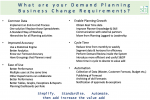 Demand Planning Change Requirements
Demand Planning Change Requirements
LinkedIn
March 29, 2021
Do you want to improve your Demand Planning Systems, Processes, Data & Resource Skill? What is on your list of business change requirements?
Here's a selection.. but is anything missing? What would you like to change for the better?
See publication
Tags: Business Strategy, Predictive Analytics, Supply Chain
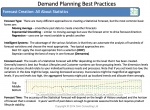 All About Statistics Part 1
All About Statistics Part 1
SHJ Consulting Ltd
March 29, 2021
Forecast Type: There are many different approaches to creating a Statistical Forecast, but the most common basic forms are:
Moving Average – smoothens past data to create smoother forecasts
Exponential Smoothing – similar to moving average but uses the forecast error to drive forecast direction
Regression – uses one (or more) variable to predict another
See publication
Tags: Analytics, Predictive Analytics, Supply Chain
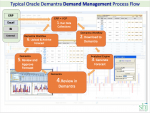 Demand Management Process Flow
Demand Management Process Flow
Linkedin
March 17, 2021
Typical Demand Management Process Flow.
1. Run Data Collections (validate & error filtering)
2. Download into Demantra
3. Run Analytical Engine to generate combinations and Forecast
4. Review Forecast for
4.1 Drift, Life-Cycle, Models, Hierarchy etc.
4.2. Previous Approved Forecast v Actuals, Budget, Last Year, Causals, Syndicated Data etc.
4.3. Exceptions for Tolerance, Trend, New Promotions etc. by Segmentation & Pareto
4.4. Tune Forecast via Simulations or Tuning Environment.
4.5. Override the Statistical Forecast with Judgmental Input
5. Check & Approve Forecast
6. Upload Forecast & Archive
See publication
Tags: ERP, Predictive Analytics, Supply Chain
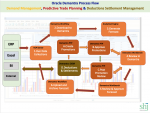 Demand Management Process with Promotions and Deductions inside it.
Demand Management Process with Promotions and Deductions inside it.
Linkedin
March 17, 2021
A Demand Management Process Flow a short while ago with Promotions and Deductions Process Flow inside it.
A. Create Promotions
B. Approve Promotions
C. Post Promotion Review
D. Deductions & Settlements
1. Run Data Collections (validate & error filtering)
2. Download into Demantra
3. Run Analytical Engine to generate combinations and Forecast
4. Review Forecast
4.1 Drift, Life-Cycle, Models, Hierarchy etc.
4.2. Previous Approved Forecast v Actuals, Budget, Last Year, Causals, Syndicated Data etc.
4.3. Exceptions for Tolerance, Trend, New Promotions etc. by Segmentation & Pareto
4.4. Tune Forecast via Simulations or Tuning Environment.
4.5. Override the Statistical Forecast with Judgmental Input
5. Check & Approve Forecast
6. Upload Forecast & Archive
See publication
Tags: ERP, Predictive Analytics, Supply Chain
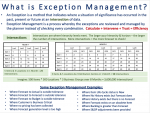 What is Exception Management?
What is Exception Management?
Linkedin
March 14, 2021
What is Exception Management?
An Exception is a method that indicates where a situation of significance has occurred in the past, present or future at an intersection of data.
Exception Management is a process whereby the exceptions are reviewed and managed by the planner instead of checking every combination.
Do you Demand Plan by exceptions or is it up, down and across the whole dataset every Cycle?
Calculate + Intervene + Trust = Efficiency
#demandplanning #demandforecasting #exception #oraclecloud #forecasting #supplychaintransformation
See publication
Tags: Analytics, Predictive Analytics, Supply Chain
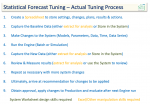 Tuning Your Statistical Forecast - Actual Tuning Process Steps
Tuning Your Statistical Forecast - Actual Tuning Process Steps
Linkedin
March 12, 2021
Tuning a Statistical Forecast Part 7. What are the actual steps?
See the Infographic for 9 steps to tuning heaven. If you followed parts 1 to 6 you will now know who will do the tuning, how they will do it, where they will do it, why they are doing it, the impact they might get and the actual data they will do it on.
The last part is the recording and doing of the tuning. So, assuming that you are doing it yourself...
1. Get a master spreadsheet built to store all the data decisions
2. Capture the base data before you change anything!
3. Change the System Settings (Methods 1 to 8)
4. Run the Statistical Forecast Creation Process
5. Capture the results
6. Review & Measure the results
7. Repeat 6 until you've captured enough results
8. Review results and reach decision on changes to keep
9. Get approval, make the changes in Production, run, review and if all is good - keep tuning!
See publication
Tags: Analytics, Predictive Analytics, Supply Chain
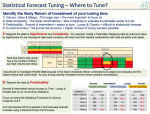 Tuning a Statistical Forecast Part 6 - Choose Your Battles Wisely
Tuning a Statistical Forecast Part 6 - Choose Your Battles Wisely
LinkedIn
March 11, 2021
Tuning a Statistical Forecast Part 6. How do you decide where to apply tuning methods?
Now we are getting into territory that most will be familiar with – your data! There are many different ways to go about this and the driving factors will be your business needs and your tuning maturity.
If you are starting out your tuning – the key thing is to keep it simple AND effective.
See the Infographic:
1/ Investigate your data to find combinations that have IMPACT (from a business perspective) and are yet SIMPLE (from a structure perspective). I recommend a ‘heat map’ for quick visual identification though 80/20 and other sorting criteria will work fine too.
2/ Segment the data by PREDICTABILITY. Identify the combinations in the SIMPLE category by their predictability and accuracy. Where combinations are misses – work on tuning the forecast (use the methods described in Part 2).
See publication
Tags: Analytics, Predictive Analytics, Supply Chain
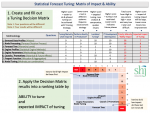 Statistical Forecast Tuning Matrix of Ability and Impact
Statistical Forecast Tuning Matrix of Ability and Impact
Linkedin
March 08, 2021
Tuning a Statistical Forecast Part 5.
Previously I posted a Statistical Forecast Tuning Resource Strategy, a list of Statistical Forecast Methodology steps, a framework of Statistical Forecast Strategic Elements and some key Statistical Forecast Procedure Decisions. But there's more!
You need to understand your ability to tune the statistical forecast using the methods and the expected impact of your tuning.
Given limited resource & / or Maturity in the Planning Team a decision matrix can be used to determine the functional priority of the Methods used in Statistical Forecast Tuning. See the Info-diagram for the two steps.
The results of this kind of approach can then determine your Tuning Strategy, Timetable & (if necessary) Training Plan. The Matrix should be re-evaluated as maturity and tuning progresses, since tuning as targets are achieved and skills improve.
Next you will want to understand exactly where to apply these methods in your dataset and I will elaborate this in more detail in Part 6.
If you would like to discuss how these strategies could be utilised to resolve your forecasting woes please send me a DM and let the conversations begin!
See publication
Tags: Analytics, Predictive Analytics, Supply Chain
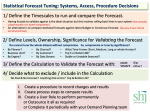 Statistical Forecast Tuning Decisions
Statistical Forecast Tuning Decisions
Linkedin
March 05, 2021
Tuning a Statistical Forecast Part 3.
In Tuning a Statistical Forecast Part 2 I listed a larger framework of strategic elements that surround 9 Statistical Forecast tuning methods from Tuning a Statistical Forecast Part. But there's more. You need to decide:
Timescales: Will there be actuals to evaluate against the forecast?
Levels: What & where to measure the tuned forecasts.
Calculation: What method to measure the tuned forecasts.
Exclusions: What to ignore from the dataset
So with methods understood, a framework to use, and decisions about the time-frame, levels, and focus you can create a matrix to decide what, how & where to tune and who should do it.
If you would like to discuss how these strategies could be utilised to resolve your forecasting woes please send me a DM and let the conversations begin!
See publication
Tags: ERP, Predictive Analytics, Supply Chain
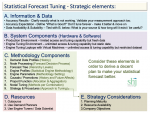 Statistical Forecast Tuning - Strategic Elements
Statistical Forecast Tuning - Strategic Elements
Linkedin
March 04, 2021
Previously I listed 9 key steps for tuning a statistical forecast and pointed out that the last step (Procedures) is really the first but to perform it you need to have evaluated all the others first...
Well, here's those 9 steps but now within a larger framework of strategic elements. You need to understand:
Data: (What) & Information (What is bad & What would be good).
Systems: Where do you do the tuning - Dev, Train, Prod, Other?
Methodology: The 9 steps of actually doing the tuning.
Resources: Who can do the tuning.
Strategy: Business Capabilities & Objectives
If you would like to discuss how these strategies could be utilised to resolve your forecasting woes please send me an email or DM or call or text or comment or telegram or smoke signal or breaker breaker CB radio call or carrier pigeon message and even an actual hand written note in the post - let the conversations begin!
See publication
Tags: Analytics, Predictive Analytics, Supply Chain
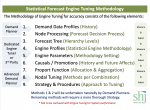 Statistical Forecast Tuning Methodology
Statistical Forecast Tuning Methodology
Linkedin
March 03, 2021
Statistical Forecast Creation Problems?
Here are 9 key steps to improve your statistical forecasts.
1/ History - clean and adjust to create the best forecast
2/ Decision Process - Life-Cycle / Segments / On or Off
3/ Hierarchy Levels - Review results and drive better usage
4/ Engine & Models - Models and number of Engines or Plans
5/ Engine Settings - Tweak and change for optimal settings
6/ Causals - Add, Remove, Change to obtain the best results
7/ Proport - Assess Allocation & Aggregation Methods
8/ Nodal - Refine above per individual combinations
9/ Strategy - This one should be first but you need to know the impact and difficulty of the 8 steps before you can really set a Strategy. Which steps can be combined, do you need Training, Systems & Data? What recording & analysis methods to use? How to decide what is good before moving on?
See publication
Tags: Analytics, Predictive Analytics, Supply Chain
 Engine Tuning Resourcing Options
Engine Tuning Resourcing Options
Linkedin
February 26, 2021
Forecast results not good? Does your Statistical Engine need tuning? Changes in Organisation, Data, Resources & Strategy can impair the quality of the statistical forecast created by your engine.
Engine Tuning options with advantages & disadvantages are tabled below.
See publication
Tags: Business Strategy, Predictive Analytics, Supply Chain
 Demand Planning Pain, Panaceas & Pitfalls
Demand Planning Pain, Panaceas & Pitfalls
Linkedin
February 24, 2021
Demand Planning Pain Points, System Panaceas and Pitfalls to avoid.
Here's a one-pager that (just about!) squeezes in the most common legacy Demand Planning problems with the typical remedies that new Systems are expected to provide and then the likely pitfalls encountered when Implementing.
See publication
Tags: Change Management, Predictive Analytics, Supply Chain
 How Demand Planning fits into S&OP
How Demand Planning fits into S&OP
Linkedin
February 23, 2021
How does Demand Planning fit into S&OP? Here's an image that summarised the key steps of both. These are 'typical examples' and your business may need a different approach.
See publication
Tags: Business Strategy, Predictive Analytics, Supply Chain
 Forecast Data: Push or Pull?
Forecast Data: Push or Pull?
Linkedin
February 22, 2021
Forecast Data: Push or Pull?
See publication
Tags: ERP, Predictive Analytics, Supply Chain
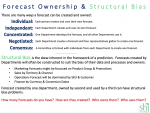 Forecast Ownership & Structural Bias
Forecast Ownership & Structural Bias
Linkedin
February 18, 2021
Forecast Ownership & Structural Bias
Forecasts created by one department, owned by second and used by a third can have structural bias and accuracy problems.
How many Forecasts do you have? How are they created? Who owns them? Who uses them?
There are many other types of Bias that can affect your forecast accuracy from conscious & unconscious, to anchoring, complexity and overfitting. These need to be understood and tackled too but if you are implementing or optimising your forecasts:
1/ Understand existing ownership and structural bias.
2/ Strategise options from 'one number forecast' to multi solution
3/ Select the right Strategy
4/ Engage, Communicate, Harmonise and get a better future going
See publication
Tags: Business Strategy, Predictive Analytics, Supply Chain
 When to Forecast Pictogram
When to Forecast Pictogram
Linkedin
February 18, 2021
A Pictogram to help visualise the different time fences to focus on.
Different Companies have different priorities depending on cycle times, product type and life, customer ordering styles etc.
Why forecast out 18 months? – Remember that your forecast can be used by many people for different purposes….
Long term now becomes medium and short term soon enough.
Measure now to gain better accuracy.
Improved accuracy can enable Planners to focus on the deviations and issues.
See publication
Tags: Predictive Analytics, Supply Chain
 How mature is your Planning?
How mature is your Planning?
Linkedin
February 17, 2021
Planning Maturity. Understand your Supply Chain Planning Maturity. Create a Planning Strategy to improve People, Process, Technology, Information, Performance Management and to enable & inform Company Vision.
See publication
Tags: Predictive Analytics, Supply Chain
 Segments, Elements & Prioritisation
Segments, Elements & Prioritisation
Linkedin
February 09, 2021
Oracle Demantra & Demand Planning users with too much data and not enough time?
How do you decide what to tune and/or override?
Don't alter the roughly right but change the definitely wrong.
Don't alter the definitely wrong if the impact is none.
Don't fuss about non-round numbers.
Only edit the impact forecast horizon.
Create segments of data & prioritise by the probable quality of the forecast and the likely benefit to be gained by changes (see diagram below).
This offers a path for tuning statistical engines and also prioritisation for adjustments.
Smooth & Intermittent forecast data should be OK but Lumpy or Erratic will always be difficult for the engine to predict accurately. Focus on the high volume, value & margin combinations in the Lumpy and Erratic data segment. Consider turning the engine off (do not forecast) for these combinations and entering a manual override that will need limited management next cycle.
See publication
Tags: Analytics, Predictive Analytics, Supply Chain
 Forecast to Forecast
Forecast to Forecast
Linkedin
February 09, 2021
Every Company has its unique challenges from Culture to Lead-times. Forecast Frequency & Horizons can all vary (as needed) for your goals but the more you naturally link forecasts, the better.
Harmonise your Dimensions, Levels & Data Streams to maximise accuracy, speed and agility!
S&OP / IBP need slick integration between all system, people and processes if they are to deliver real value.
Note: The diagram shows example horizons - each company has its own unique requirements.
See publication
Tags: Business Strategy, Predictive Analytics, Supply Chain
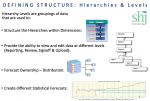 Demand Planning Hierarchy Levels - What are they good for?
Demand Planning Hierarchy Levels - What are they good for?
Linkedin
February 02, 2021
Demand Planning System Solutions require Levels (Low <> Mid <> High) within Dimensions (such as Sales Organisation, Product, Customer & Time) for Structure, Slicing & Dicing, Review, Adjust, Check, Approve and Publish processes and most crucially (but most overlooked) Statistical Forecast Generation.
Often the levels used are simply those most readily available from source systems. Sometimes they are old, incomplete, incompatible and even incorrect and require manipulation and workarounds to fix for supply chain planing activities.
See publication
Tags: ERP, Predictive Analytics, Supply Chain
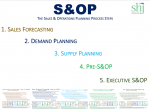 Steps inside S&OP
Steps inside S&OP
Linkedin
April 08, 2021
Sales Forecasting to Demand Planning to Supply Planning to Pre-S&OP to Executive SOP. Here are typical steps that flow through the process from end to end.
See publication
Tags: Business Strategy, Predictive Analytics, Supply Chain
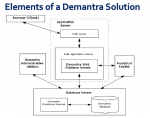 Demantra Architectural Options
Demantra Architectural Options
LinkedIn
March 30, 2021
Slides to show the different ways to construct an Oracle Demantra Solution.
See publication
Tags: Business Strategy, Predictive Analytics, Supply Chain
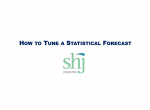 Tuning your Statistical Forecast - 7 Steps
Tuning your Statistical Forecast - 7 Steps
Linkedin
March 12, 2021
Tuning a Statistical Forecast Parts 1 through to 7.
Forecast results not good? Does your Statistical Engine need tuning? Changes in Organisation, Data, Resources & Strategy can impair the quality of the statistical forecast created by your engine. This slideshow combines 7 typical stages into 1 handy reference.
Of course, every business is different. Resource skill levels, data, systems, horizons, priority, ownership... If you would like to discuss the practicalities, activities and timetable for tuning your Statistical Forecast - send me a DM.
See publication
Tags: Analytics, Predictive Analytics, Supply Chain
 Benefits of a Statistical Forecast
Benefits of a Statistical Forecast
Linkedin
February 24, 2021
Planning in Excel? Ditch those spreadsheets, embrace the cloud and discover the benefits of integrated statistical forecasting including but not limited to:
Virtually no system downtime!
Collaboration & Security
Greater Forecast Accuracy
Faster Cycle Times
Increased Horizon
Personalised Reporting & Dashboards
Alerts & Exception Management
Planning Maturity Growth
Happier Planners
Go Digital Planning and kick start your S&OP in 2021
See publication
Tags: Digital Transformation, Supply Chain, Predictive Analytics
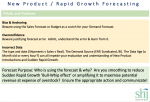 New Product Introduction & Rapid Growth Products
New Product Introduction & Rapid Growth Products
Linkedin
February 17, 2021
New Product Introductions and Rapid Product Growth are really difficult to manage in Demand Planning. Here is a slideshow that summarise the issues, challenges and solutions.
See publication
Tags: Business Strategy, Predictive Analytics, Supply Chain
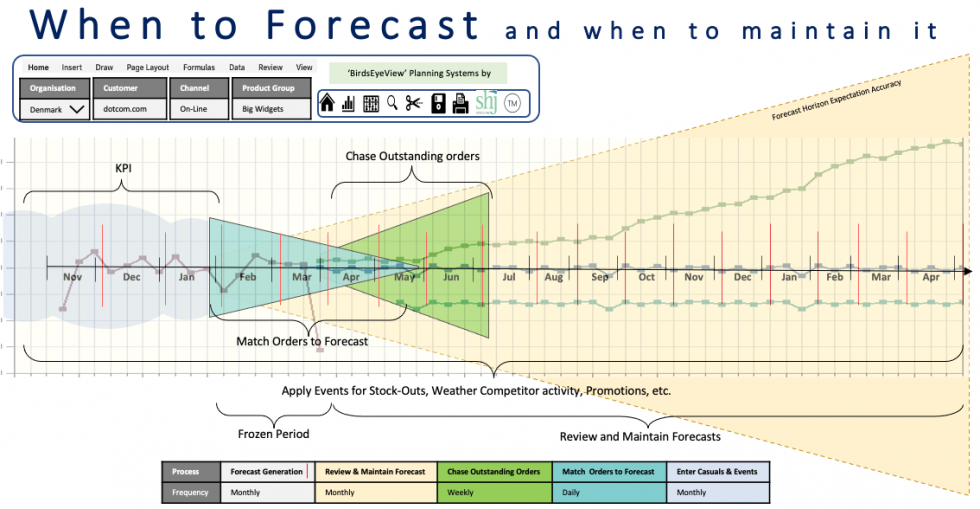

 Cars & Forecasting: Speed or Accuracy?
Cars & Forecasting: Speed or Accuracy?
 Tuning a Statistical Forecast Article 3: Strategic Elements.
Tuning a Statistical Forecast Article 3: Strategic Elements.
 Getting Value from the Supply Chain Sell-Through
Getting Value from the Supply Chain Sell-Through
 Buy-In and Sell-Out
Buy-In and Sell-Out
 Oracle Demantra Statistical Engine Tuning Components
Oracle Demantra Statistical Engine Tuning Components
 What is a Forecasting Strategy?
What is a Forecasting Strategy?
 Tuning a Statistical Forecast Article 1: Resource Options
Tuning a Statistical Forecast Article 1: Resource Options
 Demand Planning Panaceas
Demand Planning Panaceas
 ORACLE DEMAND MANAGEMENT CLOUD
ORACLE DEMAND MANAGEMENT CLOUD
 Oracle Demantra versus Demand Management Cloud: Structures
Oracle Demantra versus Demand Management Cloud: Structures
 Demand Planning Pain Points
Demand Planning Pain Points
 Oracle Demand Management Cloud Introduction
Oracle Demand Management Cloud Introduction
 Who Forecasts?
Who Forecasts?
 Where to Forecast?
Where to Forecast?
 System Implementation & The Integrators
System Implementation & The Integrators
 When to Forecast?
When to Forecast?
 Demand Planning Pitfalls
Demand Planning Pitfalls
 What to Forecast?
What to Forecast?
 Too much data & not enough time?
Too much data & not enough time?
 How to Forecast?
How to Forecast?
 Why Forecast?
Why Forecast?
 Demand Planning Change Requirements
Demand Planning Change Requirements
 All About Statistics Part 1
All About Statistics Part 1
 Demand Management Process Flow
Demand Management Process Flow
 Demand Management Process with Promotions and Deductions inside it.
Demand Management Process with Promotions and Deductions inside it.
 What is Exception Management?
What is Exception Management?
 Tuning Your Statistical Forecast - Actual Tuning Process Steps
Tuning Your Statistical Forecast - Actual Tuning Process Steps
 Tuning a Statistical Forecast Part 6 - Choose Your Battles Wisely
Tuning a Statistical Forecast Part 6 - Choose Your Battles Wisely
 Statistical Forecast Tuning Matrix of Ability and Impact
Statistical Forecast Tuning Matrix of Ability and Impact
 Statistical Forecast Tuning Decisions
Statistical Forecast Tuning Decisions
 Statistical Forecast Tuning - Strategic Elements
Statistical Forecast Tuning - Strategic Elements
 Statistical Forecast Tuning Methodology
Statistical Forecast Tuning Methodology
 Engine Tuning Resourcing Options
Engine Tuning Resourcing Options
 Demand Planning Pain, Panaceas & Pitfalls
Demand Planning Pain, Panaceas & Pitfalls
 How Demand Planning fits into S&OP
How Demand Planning fits into S&OP
 Forecast Data: Push or Pull?
Forecast Data: Push or Pull?
 Forecast Ownership & Structural Bias
Forecast Ownership & Structural Bias
 When to Forecast Pictogram
When to Forecast Pictogram
 How mature is your Planning?
How mature is your Planning?
 Segments, Elements & Prioritisation
Segments, Elements & Prioritisation
 Forecast to Forecast
Forecast to Forecast
 Demand Planning Hierarchy Levels - What are they good for?
Demand Planning Hierarchy Levels - What are they good for?
 Steps inside S&OP
Steps inside S&OP
 Demantra Architectural Options
Demantra Architectural Options
 Tuning your Statistical Forecast - 7 Steps
Tuning your Statistical Forecast - 7 Steps
 Benefits of a Statistical Forecast
Benefits of a Statistical Forecast
 New Product Introduction & Rapid Growth Products
New Product Introduction & Rapid Growth Products